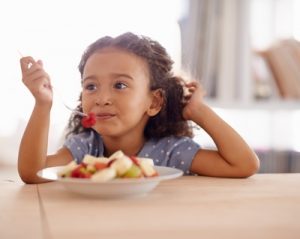By Carroll Walton, Novant Health Healthy Headlines
To find and book a pediatrician, click here.
Childhood obesity was already a significant problem, and COVID-19 has made it worse. A year of remote learning just gave children all the more reason to be sedentary and left parents looking for answers.

Dr. Traci Ladd
Dr. Traci Ladd of Novant Health Ballantyne Pediatrics points out that, even without accounting for COVID, the obesity rate for both adults and children has doubled in the past 30 years. Since COVID? “The weight has increased exponentially” for children coming into her office for checkups over the past 18 months, she said.
“That can lead to everything from heart problems, to sleep apnea and liver problems, kidney problems, joint problems, endocrine problems like diabetes,” Ladd said. “A lot of medical conditions we used to only see in adults, we are now seeing in teenagers who are obese.”
What can be done? First, Ladd said, it depends upon the age of the patient. For younger children whose parents still control what’s available to eat, there’s good news:
“If parents are diligent in changing the food that’s in the house and with getting the kids active, most of the time they just have to stop the weight gain,” Ladd said. “The child is going to keep growing and getting taller, so he or she doesn’t necessarily need to lose weight. Most of the time, just by maintaining the weight for a year, as the child grows taller, his or her body mass index will fall into the healthy range.”
For teenagers, who have their own transportation and greater independence, it can be more challenging.
“If the teenager isn’t concerned or isn’t interested, then I will often stop the discussion, because nothing I can say will make a difference,” Ladd said. “But if teenagers are concerned about their weight, then depending on where they are in their growth, the discussion can range from ‘OK, don’t gain for the next year’ to discussing healthy ways to lose weight.”
Here are six strategies Ladd shared for encouraging a healthy lifestyle at home:
1. Food for the refrigerator
 Kids really should be eating every few hours. Three meals and a couple of snacks every day is fine. It’s the choice of foods that makes the difference. Dietitians often say we should be eating out of our refrigerator more than our pantry, so I tell parents that. When it comes to snacks, you want children to have fresh or whole food as much as possible, like fruits, vegetables, cheese, or yogurt, and limit the packaged, processed chemical-laden foods.
Kids really should be eating every few hours. Three meals and a couple of snacks every day is fine. It’s the choice of foods that makes the difference. Dietitians often say we should be eating out of our refrigerator more than our pantry, so I tell parents that. When it comes to snacks, you want children to have fresh or whole food as much as possible, like fruits, vegetables, cheese, or yogurt, and limit the packaged, processed chemical-laden foods.
2. Home-cooked meals
Make as many meals at home as possible, though that does become difficult because we’re all busy. Just making better choices, making sure children have five servings of fruits and vegetables every day, and paying attention to portion sizes makes a difference.
Starting from a young age, I always tell parents that kids eat when they’re hungry, so don’t force it. Additionally, unless a child is allergic, make one meal for the family and nothing else. If they don’t want it, then let it go. No more clean plate club. Children eat when they’re hungry … they won’t starve themselves!
3. Milk and water to drink
Kids really should just be drinking milk and water. We don’t recommend juice or soda, i.e., no sugar sweetened beverages. If parents really want it then I tell them that they can get it while they are out but don’t have it in the house. If it’s not there, they can’t drink it.
4. Treats in moderation
We all want to have a treat sometimes. However, no one needs dessert every day. For those who are used to having desserts every day, I tell them to come to an agreement on what days are going to be “treat” days, whether it’s every other day or limited to certain days each week. The entire family has to make the change.
If we are modeling a fairly healthy diet and active lifestyle, but not completely limiting ourselves, then the child is also going to learn, “Oh, OK, I’m going to have some cake for my birthday, and it’s not a bad food,” but they won’t expect it every day.
5. Model exercise, too
If the parents are active, the kids will be active. It certainly doesn’t mean every parent needs to run a marathon, but even just going for a walk can influence children. The parent going for a walk with the kids is a great way to bond with them. If you’re close enough to school and the parents have time, you can walk them to school and review work or play games along the way. If you have a dog, walk it every day, or go out in the backyard and play with your children.
And when they have cell phones or other electronics, parents need to set limits on the child’s screen time. Otherwise, they’ll sit in front of the tablet, phone, the TV, computer, or video games for hours without realizing how much time has passed.
6. Encourage teenagers to exercise with a purpose
Encourage older kids to be entrepreneurial. Walk people’s dogs for them – they’ll get exercise and earn money. Kids who are old enough and are responsible can mow neighbors’ lawns, either for pay or as community service. You can be creative in how you’re getting exercise. Not every child is going to play sports competitively, but every child can be active.
Novant Health
Healthy Headlines
Facebook
Instagram
Twitter
YouTube




